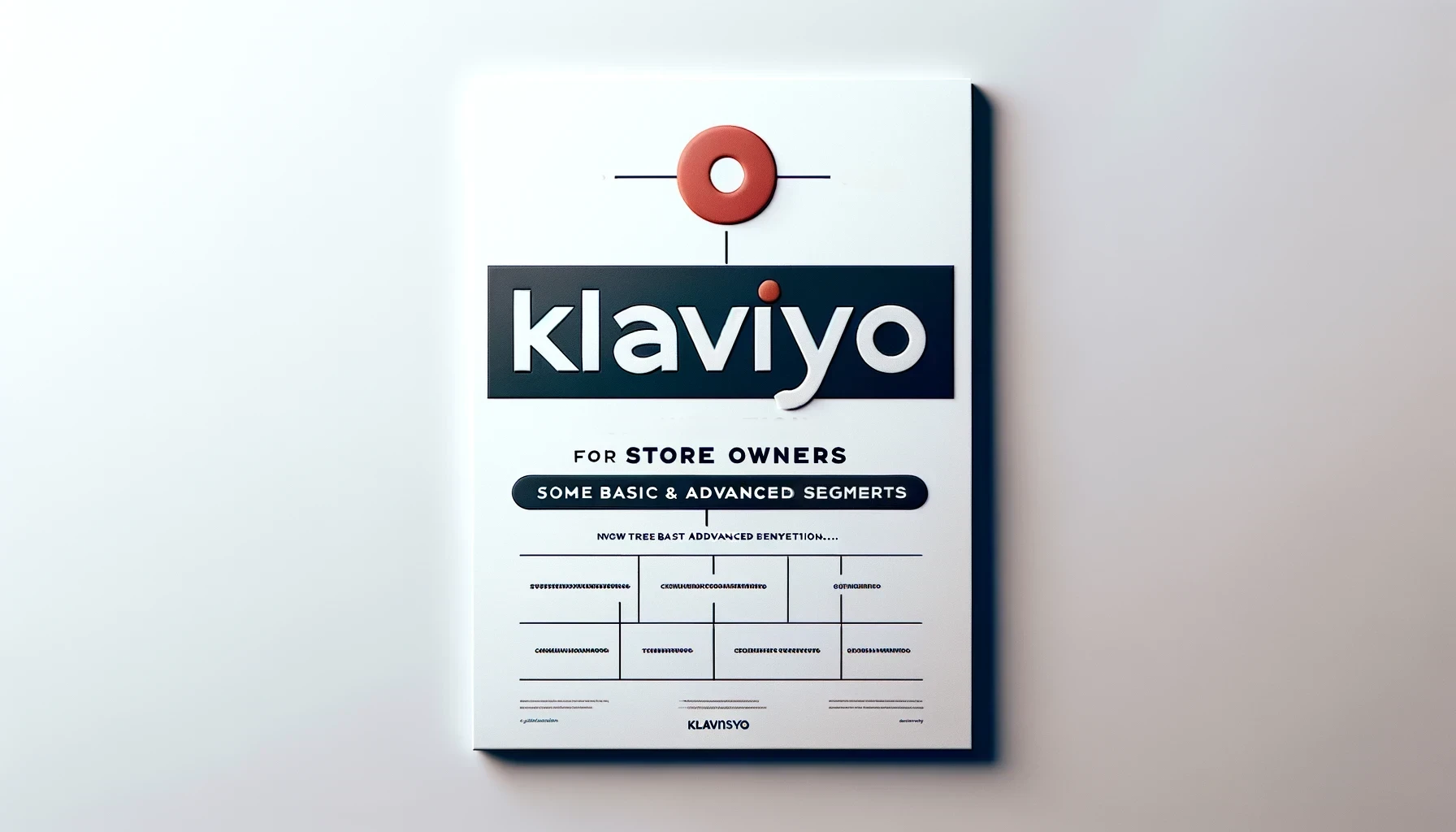Ever wondered about the age-old question:
“If a tree falls in a forest and no one’s around to hear it, does it make a sound?”
Let’s pivot from pondering nature’s mysteries to a crucial aspect of e-commerce: segmentation of email lists.
Just as in communication theory, effective marketing hinges on knowing your audience. After all, sharing a message is pointless if your recipients can’t relate to it or comprehend it.
That’s why segmentation is so important for ecommerce email marketing. You have to send the right message to the right person in order for that to be effective.
This blog is all about that. We are going to cover what segmentation is and which core segments you should create for your ecommerce brand.
Understanding Customer Segmentation
Customer segmentation involves dividing your customers into groups based on common characteristics. This practice allows you to personalize your marketing efforts, address the specific needs of different audience segments, and create more meaningful connections.
Here are some of the core segments that every ecommerce brands needs to have:
Essential Segments For Every Ecommerce Brand
1. Lifecycle Stages Segmentation
- New Subscribers: This is for any recent subscribers who have joined your subscriber list. We recommend using two weeks as a timeframe for this but you can slightly adjust that as required. One thing to note here is to make sure you’re not sending mixed messages, which can easily happen if you have a Welcome Flow as well.
Ideally, you want to exclude new subscribers from campaigns until they finish going through the Welcome / Onboarding Flow.

- Active Customers: These are customers that recently placed an order with your brand. As such, they are highly engaged with your brand at that point. There are multiple ways you can leverage this segment, such as:
– Feedback: Asking them for feedback on their purchase
– Referrals: Ask them to recommend brand to others who might love it
– Upsell / Cross-sell: You can send targeted upsell / cross-sell promosIdeally, you need to have a solid post-purchase flow for these so its automated. However, its good to be able to identify recent customers so you can guide them in the direction of other products they might love.

- At-Risk Customers: These are customers who had placed an order with you but some time has gone by without another purchase. Winback Flow is an absolute must so you can re-engage these customers. Also, if your brand does use incentives you can send a couple of more tailored campaigns to these customers.
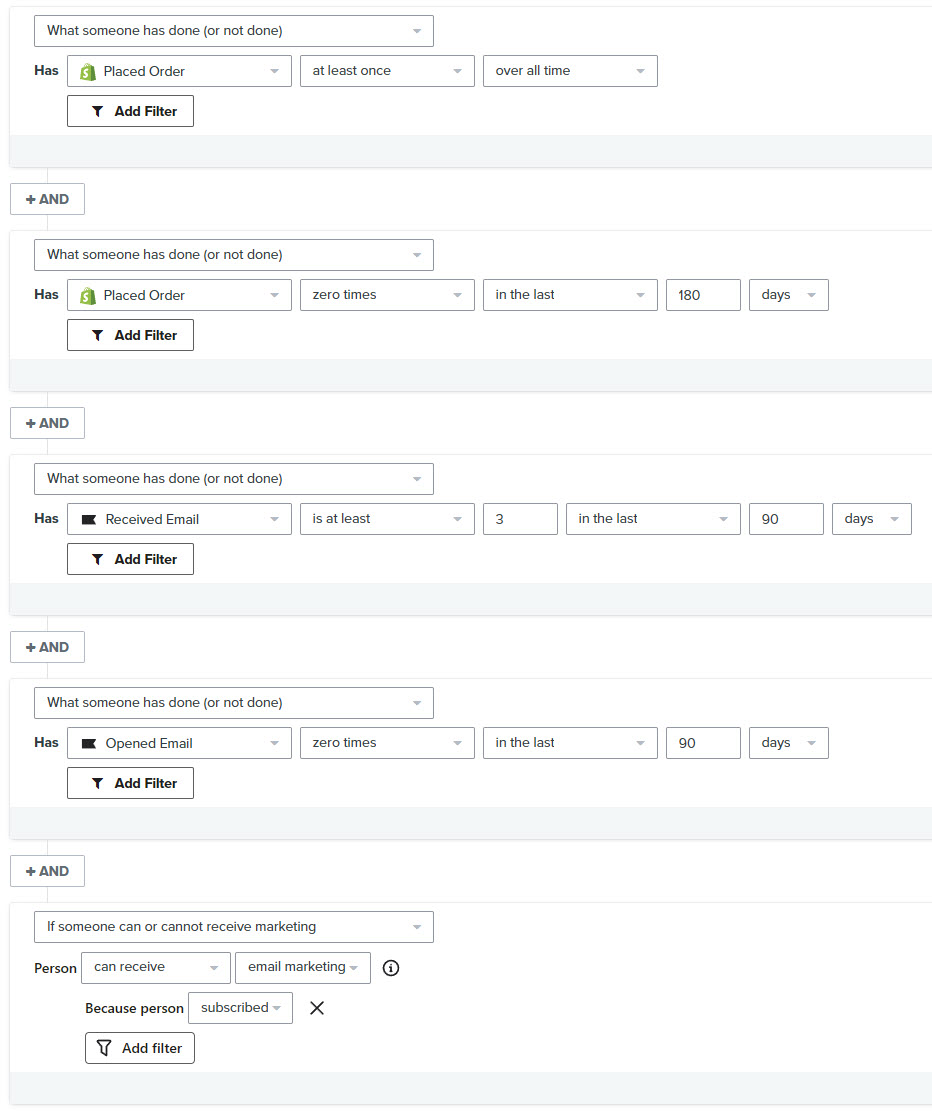
2. Purchase Behavior Segmentation
- High-Value / VIP Customers: Offer VIP treatments or exclusive discounts to your biggest spenders to maintain their loyalty. Because each brand is different, you have to define what a VIP customer looks like for your brand. You can do that on the basis of # of orders or the amount spent on your store.



- Frequent Buyers: These are customers who have placed twice or more with your brand. We want to reward their loyalty with special offers or points to encourage continuous engagement. If you do have a rewards program you should definitely have a flow promoting that to this segment. You can also do that via campaigns.


- One-Time Buyers: CLV is very important in ecommerce. This segment is somewhat similar to Active Customers but we are defining it by # of orders rather than time-frame. Here the objective is to encourage a second purchase with targeted communications that reflect their interests or past behavior.
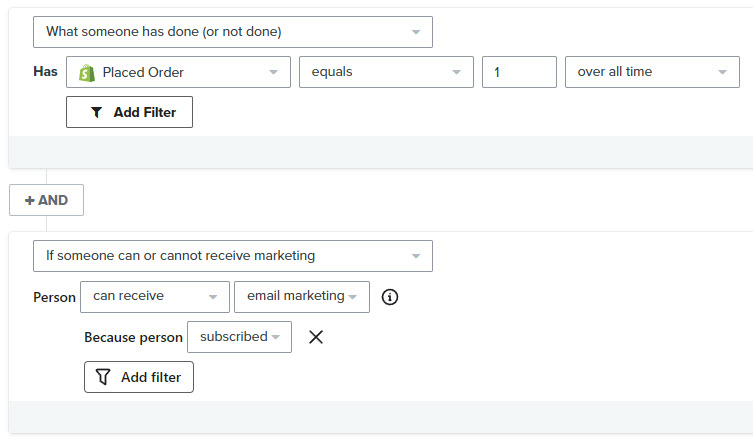

3. Interest-Based Segmentation
- Audience Based Segments: If your store offers targets multiple target audiences then you would have to tailor the messaging for each audience accordingly. The best way to go about that is collect information gradually and then create segments using that information.
An example of that is a sporting goods brand that we work with. Both parents and coaches are target audiences and we collect that information from in the 2nd step of the pop-up. Based on that information we were able to create two different segments so we could tailor the messaging in campaigns according to our target audiences.


Segment for Coaches:
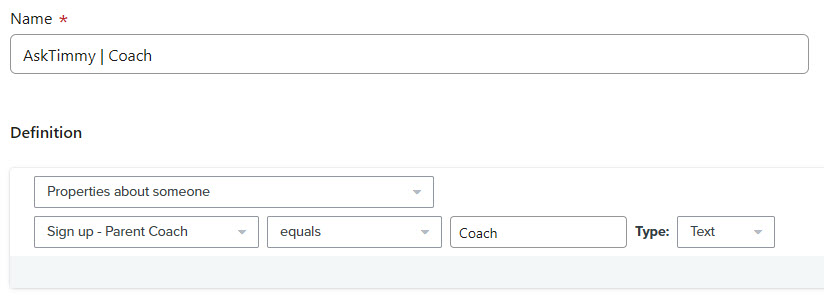

Segment for Parents:


- Product Category Preferences: If your store offers multiple product categories or offer products to different audiences you need to collect their preference in order to send the right campaign to the right person.
You can use preference page or a pop-up to collect:
– How frequently they want to hear from you
– What kind of emails they want to receive
– What products they are interested in
and so on. This helps with flows as well as then you can adjust your product feed to showcase the more relevant products in the emails by adjusting product feed. You can also reduce unsubscribe rate and spam reports by adjusting your campaign frequency for specific segments based on the information.
Here’s a customized preference page that our team created for a client of ours:


- Abandoned Cart: Target customers who left items in their cart without purchasing by offering a small discount or a reminder of what they’re missing. Abandoned Checkout does an excellent job to re-engaging these potential customers but as a segment, you can later on roll out incentive based campaigns as well to get them to make a purchase.


4. Geographic Segmentation
- Location-Based Offers: Some brands operate in multiple regions or countries. Because of that, you might have the messaging in different languages or totally different offers. For that you need geographic segmentation based on countries. However, we’ve found that this can oftentimes be tricky in a single Klaviyo account.
Here’s a very simple segment we created for a client of ours that is operating in Australia as well as USA.
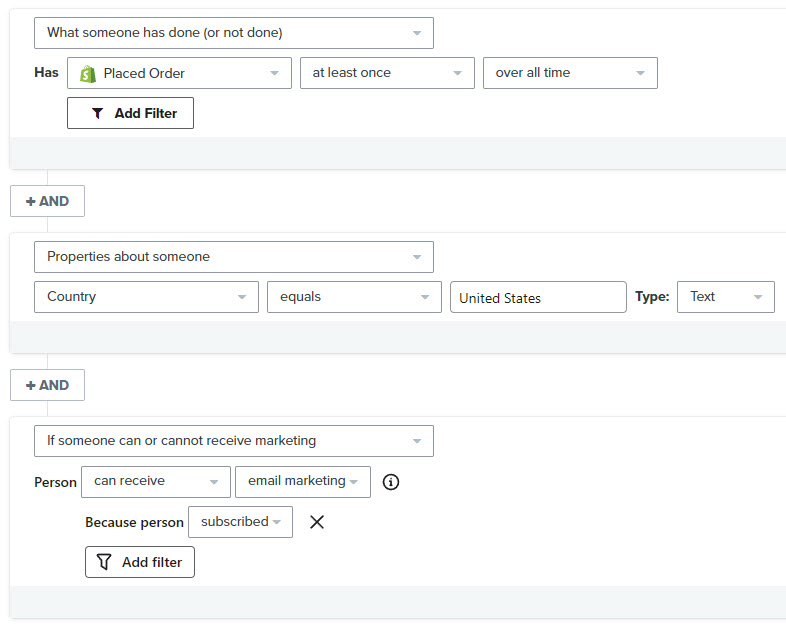

5. Engagement-Based Segmentation
- Engaged Subscribers: By default, Klaviyo sets a 30, 60, and 90 day engaged audience segments in new Klaviyo accounts. These are some of the most important segments because your metric, which is purchase, depends on whether you have a good open rate and clickthrough rate as well. Using this segment, you can make sure you are only sending campaigns to those subscribers who are engaged (have opened / clicked your email recently). Just like search engine inbox providers also keep track of how their users are interacting with your emails. Are they opening them or ignoring them? That influences whether your email lands in the inbox, promotions tab, or spam folder.
The following is an example of a standard 30 day engaged audience segment. However, there are other variations of this as well, like anyone who has clicked, opened email or subscribed to email in a certain timeframe.
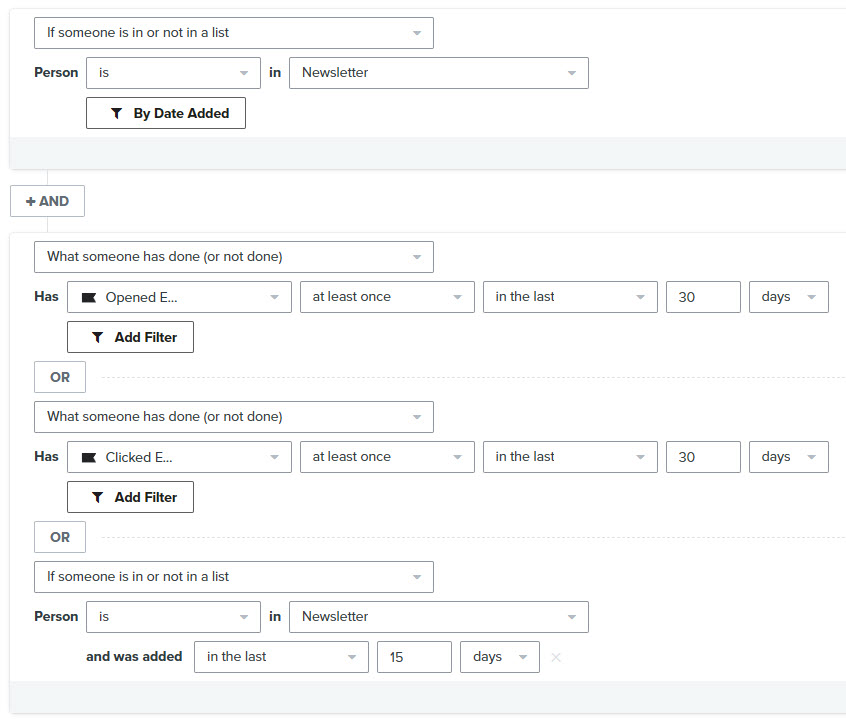

- Unengaged Subscribers: These are subscribers who have received a number of emails and haven’t opened / clicked any. As such, there is very little chance that they will convert, at least from email as a channel. Ideally you want to exclude these from your campaigns as that will help ensure you get good open rate / clickthrough rate and also so you don’t pay Klaviyo for these unengaged subscribers.
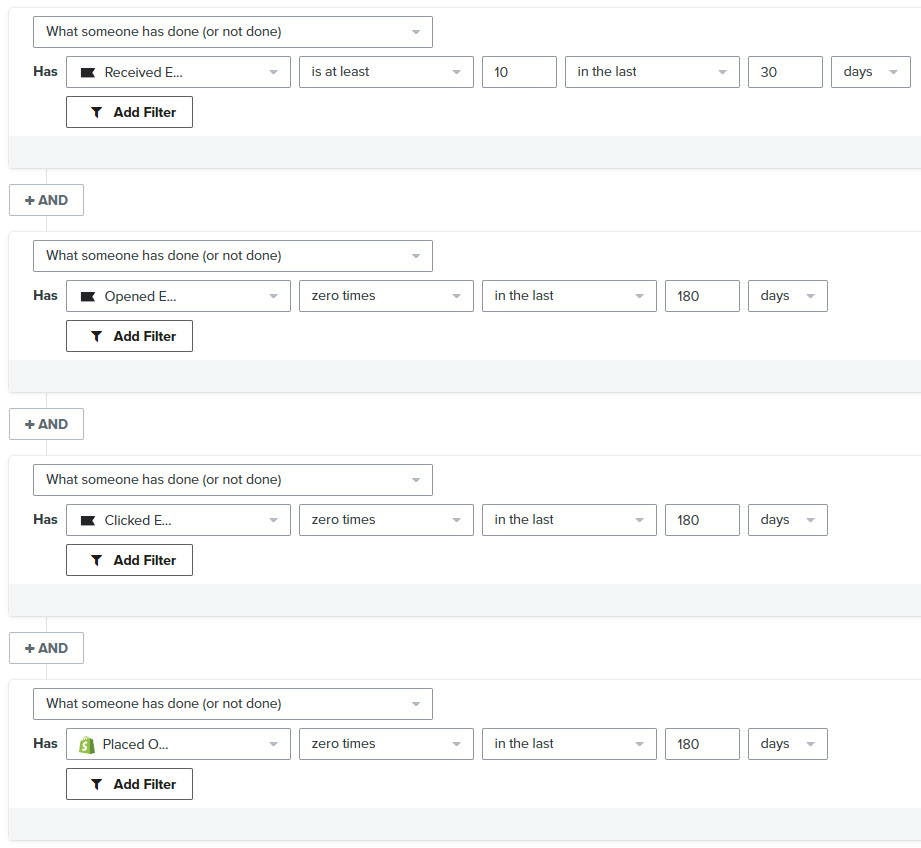

What's Next?
- Collect Relevant Data: Use sign-up forms, purchase history, and customer interactions to gather data.
- Create Segments: Klaviyo offers intuitive tools to segment your customers based on the collected data.
- Personalize Your Campaigns: Utilize these segments to send targeted emails that speak directly to the customer’s preferences and needs.
By implementing these segments, you will:
- Increase customer retention by ensuring relevancy in your communications.
- Boost conversions by addressing specific customer interests and behaviors.
- Enhance customer satisfaction through personalized experiences.
Conclusion
Customer segmentation is a powerful tool in your email marketing arsenal, especially when using a robust platform like Klaviyo. Start simple with basic segmentation and gradually refine your strategy as you become more comfortable with the features available. Remember, the goal is to send the right message to the right person at the right time, making each customer feel uniquely valued.
Ready to dive in? Set up your first segment today and watch your engagement metrics soar!
